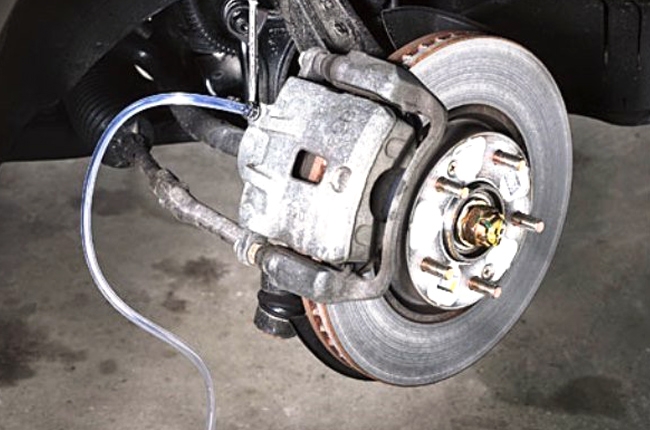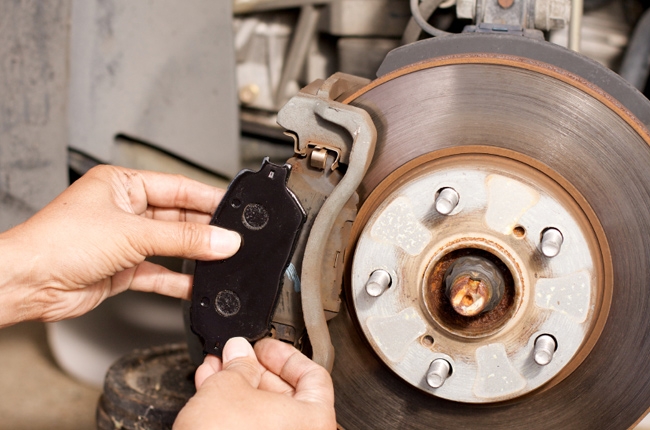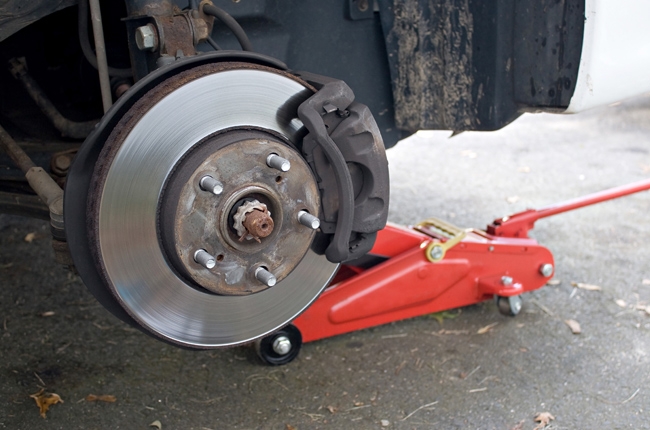
If there's anything in this world that doesn't need brakes, it's probably just the Road Runner – no more, no less. Brakes are important, especially in cars, as it's considered to be one of the most basic and primary safety features found on any type of transport, be it motorized or mechanical. New innovations make them safer and more reliable. Too bad, Wile E. Coyote had no front-collision sonars.
However, having advanced features such as front and rear sensors for automatic braking and electronic brake-force distribution doesn't mean you don't have to know how a basic brake system works and when it needs to be changed. Of course, most cars use hydraulic braking system, which means you need some brake fluid to get some stopping action, dear reader.
Ever heard of it? Do you know your car can run out of it? Do you know what happens when it does? Well, today is the day you find out.
What is a brake fluid?

Brake fluid is one of the most essential fluid in your car. Most cars use hydraulic brake systems and such type of system needs brake fluid. This fluid is a type of hydraulic liquid that transfers force into pressure, from the pedal to the calipers. Often, you may find one based in glyco-ether known for having high boiling points, while mineral and silicone-based are also available.
The fluid needs to have high boiling point to withstand the heat due to the friction when the brake pad touches the brake rotors. If it isn't because of this characteristic, the liquid will evaporate which is the last thing you want to happen as it will result to a soft brake pedal and a compromised braking power. In short, accidents will be imminent.
Can you run out of brake fluid?

"I thought it doesn't boil due to its high boiling point?" It does but in a longer period of time compared to a normal type of liquid. Regardless, high boiling point does not mean boiling-proof or no boiling point at all. You may lose a few drops over a period of time and when it's already too low, the brake fluid warning light on modern cars will light up.
But if in case your car does not have brake fluid warning lights, you can check the reservoir, which is usually the white plastic container with brake fluid label on the cap, as well as DOT level (the boiling point classification per the US Department of Transportation).
The thing is brake fluid level may drop low in a short span of time due to some serious problem. Don't be surprised by finding out an almost empty reservoir after checking it days ago. It's probably due to a leak somewhere in the brake lines, calipers, or the master cylinder.
To check for leaks, inspect if there are drips under the vehicle (normally along the undercarriage in a corner of the vehicle's rear). More so, check if there are little or big splashes along the undersides of your vehicle. Aside from the brake lines, leaks can also be found in the calipers, as well as master cylinder found under the brake fluid reservoir so might as well do a round-up check.
That said, don't ignore signs of leak.

A minor leak will require you to fill the reservoir from time to time, as it will continue to drop little by little. However, beware of any leak as it could cause you major problems if not treated earlier. It can go from bad to the worst in an instant as your brake system—whether it has the most advanced tech in the entire galaxy—will fail to stop your car the moment you needed it to.
So, what happens when you run out of brake fluid? Simple, the fluid acts as a messenger or a postman that transports the force of your foot on the pedal through the brake lines and into the brakes. Without it, you wouldn't get the optimum braking power you need in your car. Also, you'll have to exert more force in pressing the pedals just to get some braking power.
In some cases, leaks can flow to the brake pads, which in itself is very dangerous as it can compromise the friction from the rotor and the pads. Long term leak will cause the pads to wear out quicker than normal, too, which could lead to more serious problems.
Soft brake pedals could be due to air inside the brake lines.

Brake fluid is incompressible, a great reason why it is being used in hydraulic brake systems. However, in some instances, brake fluid boils, especially when you don't change your brake fluid when it needs to or in rare occasions, when water gets into the master cylinder. Boiling creates bubbles and bubbles are made of air – air is compressible.
Bubbles inside your brake lines result to softer brake pedals caused by compressed air in the brake lines. To fix this, you need to bleed your brake fluid out. Bleeding is the process wherein you get the air out of your brake lines, along with the old brake fluid. This can be done at home or you may go to an auto service center.
Bleeding your brake fuel like a boss.

In a simple brake fluid bleed, you'll require a hose and a bottle. Locate the caliper nipple, which is normally above where the brake line is connected. This is where you'll stick your clear hose in place, which is punched all the way to the bottom of the bottle through a hole in the cap. The next thing you'll do is to loosen the nut on the nipple, go to the driver seat, and pump the brakes.
the old, dark brake fluid will fill the bottle, along with some air bubbles and when you're done, tighten the nut and pull the hose off the nipple. Before you proceed to the next caliper, top off your master cylinder with new brake fluid to replace the bled-out one. Do this to the remaining calipers, and you should have an air-free, fresh brake fluid for optimum braking power.
Remember to check your vehicle owner's manual to find out what DOT level you should use to refill your master cylinder.
Wait, brake pads cause low brake fluid?

While leak is considered to be one common cause of low brake fluid, it is also known that a worn-out brake pad also causes your fluid to drop low. With thin brake pads, the caliper piston will need to go a little farther toward the brake pads and away from its housing. This causes the level of your fluid to go farther down and may deplete over time due to boiling.
With that said, checking and changing your brake pads whenever it is needed is the best thing to do. If you notice a hard time putting on some stopping action in your vehicle, consider checking the brake pads on your calipers. Normally, a new brake pad is 12-mm thick so if you find your pads approximately 3 mm, which is 25% of the usual thickness, don't slack off and have a replacement.
Replacing your brake pads

In changing your brake pads, be sure to fill your brake fluid all the way to the full mark. Wearing out brake pads will result to lowering your brake fluid so you better top it off. First, you'll need to loosen the lug nuts with a ratchet or a breaker bar while the car is firmly secured on the ground. When all is loose, get a car jack and raise your car so you could completely remove your wheels.
When your wheels are all out, you may now loosen the calipers secured by either 12 mm or 14-mm bolts. Unscrew one of the bolts to swing the calipers up and get access to the brake pads. When the caliper is open, pry out the old brake pads using a flat-head screwdriver. Do this method to the brake clips, as well. Now, install the new brake clips and pads in place and put the caliper back, securing the bolt tightly.
You may also change the rotors if they're already worn out. You may do it by taking the calipers off, wanking the rotors two to three times as needed and, voila, your old rotors can be pulled out easily. Fit your new rotor in and secure the caliper back in place. Put the wheels back in and tighten the lugs – you're now good to go.
Remember, brakes are one of the most essential features of your car. Taking good care of it could literally mean taking good care of yourself and your passengers. Ignoring the early signs could result to a possible additional expense—worst, might put you, your loved ones, and other road users in danger.
Latest Features
-
The difference between wax and polish / Tips & Advice
Confused about whether your car needs a wax or polish? This article will guide you on what they are and what to choose for your car.
-
The 6 things every Ford Ranger must pass before it leaves the factory / Featured Article
Every Ford Ranger, from the base model to the Ranger Raptor, goes through a full inspection process before it leaves the factory. This includes six steps that make sure it’s ready to drive a...
-
Which GAC AION EV is best for your everyday lifestyle? / Featured Article
The GAC AION lineup has something for everyone, maybe you're after space, speed, or just a smooth city drive. Here's a quick breakdown of which model might work best for your day-to-day life...
Popular Articles
-
Cheapest cars under P700,000 in the Philippines
Jerome Tresvalles · Sep 02, 2024
-
First car or next car, the Ford EcoSport is a tough package to beat
Jun 18, 2021
-
Car Maintenance checklist and guide – here’s everything you need to know
Earl Lee · Jan 12, 2021
-
Most fuel efficient family cars in the Philippines
Bryan Aaron Rivera · Nov 27, 2020
-
2021 Geely Okavango — Everything you need to know
Joey Deriquito · Nov 19, 2020
-
Family cars in the Philippines with the biggest trunks
Sep 20, 2023
-
Head to head: Toyota Rush vs. Suzuki XL7
Joey Deriquito · Oct 28, 2020
-
Why oil changes are important for your car
Earl Lee · Nov 10, 2020
-
2021 Kia Stonic — What you need to know about it
Joey Deriquito · Oct 16, 2020
-
Top 7 tips for buying a used car in the Philippines
Joey Deriquito · Nov 26, 2020



